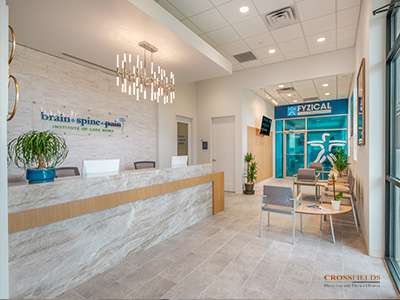
Design principles are never timeless; instead, they evolve with cultural influences. On average, the design style will “date” every seven years. A designer’s goal is to stay ahead of the curve so that designs have the longest “staying” power for your office. it is the same for interior design for holistic healthcare offices.
When designing your office, there are more than 4,000 decisions that will be made that all build upon each other. To begin, here are three key categories that will impact the foundation of your design and keep it on trend for the future.
Style
First, for every project, start with your style. “Style” is the overall direction the project will take. The simplicity of the “mid-century modern” influence continues to dominate right now. Lines are clean and elements are lighter in scale, and more minimalistic.
As was the directive in this era, spaces, and floor plans are more open and continuous, creating a sense of community.
Healthcare interior design: color
After establishing your style, begin to set the tone with the colors you would like in your space. There are many studies on colors and how they affect people psychologically. Right now, gray as the neutral is still dominant. We see this year that this popular shade has warmed and lightened and is often mixed with a warm, complementary neutral color.
With the new gray as an overall neutral background, we see bolder colors providing contrast. Navy and orange/rust are rising, as well as mixtures of healing greens, and shades of pink and coral. These colors are combined by designers in a technique called Contrast (see more in “Putting it all together” below). Using more low-contrast colors — which are closer together in value and hue — will create a more intimate and softer, quieter environment. On the other hand, using high-contrast colors will create more drama and energy.
Texture and pattern
After style and color, you can begin to add more interest with texture and pattern. More dramatic textures and patterns are becoming more prevalent in the design space. The luxury vinyl floors mimicking neutral wood and smooth stone are giving way to those that express man-created patterns with a lot of character and texture. Carpet patterns are also becoming more pronounced in healthcare interior design, both in a woven textural effect or a dramatic and contrasting color/pattern.
Instead of dominating your space with rough, reclaimed wood, mix other textures in to stay more on-trend. If you want to keep reclaimed wood, let it be more refined and add some smooth fabric on chairs or smooth flooring.
A few classic textures you can always use:
- The stone wall brings nature and strength into any environment.
- Wood brings warmth and community into any space. We see woods getting redder and/or lighter, taking on a variation of the mid-century modern with added dominant linear grain patterns for many.
- Natural textures such as marble and granite bring depth and a variety of interests. These are becoming more available since they are now less expensive man-made versions.

Putting design principles together
The three categories above are what we call “elements of design.” These elements are the building blocks and tools of design. In the classes I teach, we review the key “principles of design” as well. These principles are the time-tested foundational guidelines on how to use elements of design to create a successful interior. These principles are Balance, Rhythm, Emphasis, Contrast, Proportion, and Harmony. All principles must be adhered to in order to create a well-designed space, with the unifying factor being harmony.
The dictionary defines harmony as “a consistent, orderly or pleasing arrangement of parts, forming a pleasing consistent whole.” This is where designers do their magic. A designer can take the above elements (plus many more) and create harmony. When all the elements of the space work together, complement each other, and cooperatively transition between each other, harmony is achieved, and a successful “put-together” environment is created.
Focus on these key elements, and your interior design will become unique to you and your patients, and something you are proud of for many years to come.
This article was written for and published in ChiroEconomics magazine. See the ChiroEconomics site for more information.





